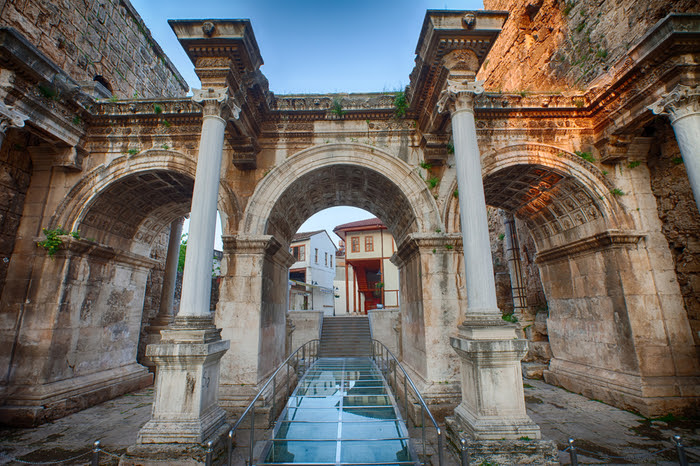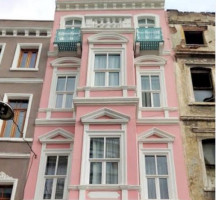Antalya on the Mediterranean coast of Turkey is one of the top tourism hotspots in the country. Marketed by the mainstream travel industry as a cosmopolitan resort, it is popular with many nationalities including Germans, Americans, Russians and of course domestic Turks who just simply can't get enough of Antalya.
Quoted highlights from guidebooks of the region often include sandy beaches, a vibrant nightlife scene, beauty of the surrounding plains filled with fruit farms, and most importantly, the numerous ancient ruins. The wonderfully preserved collection dotted all over the region, will become a favourite for anyone with a passion for the past. Previously known as Pamphylia throughout its historical timeline, Antalya is a living museum.

At the heart of Antalya city centre, is the old quarters that sit next to the harbour and promote a surreal existence. The clock tower, dating from 1244, marks the entrance but the most photographed part of the structure is the impressively intact Hadrian’s Gate.
The three arched, white marble structure dating from 130 AD has required little restoration throughout its lifeline. Surrounding it are the old city walls still stand and although this area is not technically classed as ancient ruins, it should be your first port of call on a history tour because daily life on the cobbled streets, combined with the historical importance will get you in the mood to explore further.

Prominent Perge
The ancient city of Perge was an important trading post, around the year 1300 B.C. Its citizens enthusiastically welcomed Alexander the Great into the compound and it was not until the Byzantine era that its successful existence started ending, when the coastline edged further away, reducing its ability to accommodate sea traders.
Impressive structures to see at the excavated ruins include the Hellenistic Red Tower, the 14,000 seated theatre, public bathhouses and an agora from the 4th century AD. A second century sarcophagus and statues of various emperors, found at Perge are now on display in the Antalya Archaeological Museum.

Admire the Glory of Aspendos
25 miles east of Antalya city centre is the imposing and majestic ruins of Aspendos that daily receive hundreds of visitors. Its marvellously intact theatre, seating 15,000 people was built around 161 AD and is considered by leading historians as one of the best-preserved Roman structures in the world.
From there, explore the acropolis, agora, and an aqueduct but to add a twist to your visit, buy a ticket for the annual Antalya Ballet and Opera festival that is held in the ancient theatre, every June. The acoustics during performances at night time are immensely jaw dropping.
The Pirates of Phaselis
Phaselis belonged to the ancient Pamphylia region but its origins are from the Lycian period. Founded in the 7th century BC, its unique location, situated between two beaches, has also made it a popular stopping point on daily boat tours of the region.
Throughout history, it was an immensely successful trading port but unfortunately, faced demise because of constant attacks by pirates that forced citizens to desert the city in favour of safer locations inland. Phaselis pales in size, compared to sites like Aspendos but is still worth a visit to see excavated ruins such as the agora, small theatre, and bathhouse. It is open daily from 8.30 am to 7pm.
Side Town Centre and the Temple of Apollo
The coastal resort of Side has a quirky atmosphere because the town was developed around the ancient ruins by those who live in Side, and all effort has been made to preserve them. Situated in the heart of the area, which throughout history was a major slave trading centre, are numerous Roman and Byzantine structures that promotes Side as an impressive, living open-air museum.
The spectacular scenery includes Roman shops, a large theatre, Roman public baths, and an agora. Many artefacts found at these ruins are displayed in the town museum that is open every day apart from Monday.
After exploring these ruins, head down to the seafront to find the Temple of Apollo. Although just a few columns remain, its appearance becomes even more majestic when backed by the vibrant, orange Mediterranean sunset.

Mythological Olympos
These ruins, sitting between the resorts of Cirali and Olympos, could be the setting for a fairy-tale story. Their location in among a dense forest, promotes a mythological appearance and although signage is lacking, it is worth navigating the woodland to find the Christian churches, Roman portal, Byzantine aqueduct, houses and most importantly the sarcophagus of Captain Eudemos. The inscription on the front reads:
Note: To complete a historical tour of the region, visit the Antalya Archaeological museum that holds many artefacts from nearby excavations and ruins. Open from 9am to 7.30pm, it is classed as one of the best museums in Turkey. As well as displays of uncovered artefacts dating from the Bronze Age, from time to time, there are various special exhibitions about current on-going excavation projects in the rest of the country.
Quoted highlights from guidebooks of the region often include sandy beaches, a vibrant nightlife scene, beauty of the surrounding plains filled with fruit farms, and most importantly, the numerous ancient ruins. The wonderfully preserved collection dotted all over the region, will become a favourite for anyone with a passion for the past. Previously known as Pamphylia throughout its historical timeline, Antalya is a living museum.

Ancient Ruins to Visit in Antalya
The Old Town of KaleiciAt the heart of Antalya city centre, is the old quarters that sit next to the harbour and promote a surreal existence. The clock tower, dating from 1244, marks the entrance but the most photographed part of the structure is the impressively intact Hadrian’s Gate.
The three arched, white marble structure dating from 130 AD has required little restoration throughout its lifeline. Surrounding it are the old city walls still stand and although this area is not technically classed as ancient ruins, it should be your first port of call on a history tour because daily life on the cobbled streets, combined with the historical importance will get you in the mood to explore further.

Prominent Perge
The ancient city of Perge was an important trading post, around the year 1300 B.C. Its citizens enthusiastically welcomed Alexander the Great into the compound and it was not until the Byzantine era that its successful existence started ending, when the coastline edged further away, reducing its ability to accommodate sea traders.
Impressive structures to see at the excavated ruins include the Hellenistic Red Tower, the 14,000 seated theatre, public bathhouses and an agora from the 4th century AD. A second century sarcophagus and statues of various emperors, found at Perge are now on display in the Antalya Archaeological Museum.

Admire the Glory of Aspendos
25 miles east of Antalya city centre is the imposing and majestic ruins of Aspendos that daily receive hundreds of visitors. Its marvellously intact theatre, seating 15,000 people was built around 161 AD and is considered by leading historians as one of the best-preserved Roman structures in the world.
From there, explore the acropolis, agora, and an aqueduct but to add a twist to your visit, buy a ticket for the annual Antalya Ballet and Opera festival that is held in the ancient theatre, every June. The acoustics during performances at night time are immensely jaw dropping.
The Pirates of Phaselis
Phaselis belonged to the ancient Pamphylia region but its origins are from the Lycian period. Founded in the 7th century BC, its unique location, situated between two beaches, has also made it a popular stopping point on daily boat tours of the region.
Throughout history, it was an immensely successful trading port but unfortunately, faced demise because of constant attacks by pirates that forced citizens to desert the city in favour of safer locations inland. Phaselis pales in size, compared to sites like Aspendos but is still worth a visit to see excavated ruins such as the agora, small theatre, and bathhouse. It is open daily from 8.30 am to 7pm.
Side Town Centre and the Temple of Apollo
The coastal resort of Side has a quirky atmosphere because the town was developed around the ancient ruins by those who live in Side, and all effort has been made to preserve them. Situated in the heart of the area, which throughout history was a major slave trading centre, are numerous Roman and Byzantine structures that promotes Side as an impressive, living open-air museum.
The spectacular scenery includes Roman shops, a large theatre, Roman public baths, and an agora. Many artefacts found at these ruins are displayed in the town museum that is open every day apart from Monday.
After exploring these ruins, head down to the seafront to find the Temple of Apollo. Although just a few columns remain, its appearance becomes even more majestic when backed by the vibrant, orange Mediterranean sunset.

Mythological Olympos
These ruins, sitting between the resorts of Cirali and Olympos, could be the setting for a fairy-tale story. Their location in among a dense forest, promotes a mythological appearance and although signage is lacking, it is worth navigating the woodland to find the Christian churches, Roman portal, Byzantine aqueduct, houses and most importantly the sarcophagus of Captain Eudemos. The inscription on the front reads:
“The ship sailed into harbour and anchored to leave no more,
As there was no longer any hope from the wind or daylight,
After the light carried by the dawn had left Captain Eudemos,
There buried the ship with a life as short as a day, like a broken wave.”
As there was no longer any hope from the wind or daylight,
After the light carried by the dawn had left Captain Eudemos,
There buried the ship with a life as short as a day, like a broken wave.”
Note: To complete a historical tour of the region, visit the Antalya Archaeological museum that holds many artefacts from nearby excavations and ruins. Open from 9am to 7.30pm, it is classed as one of the best museums in Turkey. As well as displays of uncovered artefacts dating from the Bronze Age, from time to time, there are various special exhibitions about current on-going excavation projects in the rest of the country.








